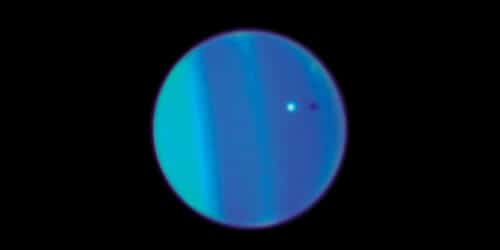Since Voyager 2 passed by Uranus in 1986 no spacecraft has been launched to it. Therefore, all the observations and studies of this planet were and are being done using telescopic observations from Earth and the Hubble Space Telescope.

Since Voyager 2 passed by Uranus in 1986 no spacecraft has been launched to it. Therefore all the observations and studies of this planet were and are being done using telescopic observations from Earth and the Hubble Space Telescope. There is a significant difference between telescopic observations and those made from a spacecraft orbiting a planet or landing on its surface. That is why all studies of Uranus are a glimpse and even less. The improvement that has been made in recent years in the telescopic equipment makes it possible to distinguish more details, compared to what was known before. In this article we will present these details.
When the Hubble Space Telescope was pointed at Uranus in November 2011, two auroras were observed on its day side (1). Do not forget that because of its angle of inclination, Uranus rolls on the plane of its movement around the sun and therefore its day is also its year. Since there is no possibility of knowing what is happening in terms of the glow at its other pole, its poles are each at the time directed towards the sun and it seems that this has some kind of connection in terms of the interaction between the solar wind and the poles. Don't forget that every pole for half a year of Uranus, 75 earthly years, either partially or fully faces the sun. To illustrate, the side of the moon that is always facing the earth reveals its face. These are slowly exposed with their exposure to sunlight. The duration of the aurora of Uranus, at least according to the observations made so far, is a few minutes. Differences in brightness were found between the telescopic observations and those made by Voyager 2 (2).
An observation made by the Gemini telescope showed a bright spot in the atmosphere of Uranus. It is estimated that this is an eruption of methane ice, high in the atmosphere(3). If indeed it is methane, what caused this eruption? Are there more methane eruptions in the atmosphere and how often? What is the source of methane? Is there a distinct characterization of all the methane eruptions throughout the day of Uranus, or is there no difference between the day side and the night side? No answers yet.
Infrared images taken by the Keck Observatory captured storms. Some of the storms are fixed in the same latitudes and a lot of activity takes place there. Other storms move towards the equator and undergo changes in size and shape. A band of storms was found south of the equator and a swarm of convective formations (convective feathers) in the North Pole that were not seen in the South Pole. According to one hypothesis, methane is pushed north by a leading band in the atmosphere towards the pole, where it is lifted upwards and creates convective patterns (4).
Since the Uranus equinox in 2007, the North Pole began to slowly enter the field of view of the telescopic observations and the South Pole was no longer visible. In observations made several years earlier, a bright spot was noticed under the haze of the pole and it resembles a glacier that broke off from the ice shelf and for this reason was given the name Berg. It is visible under the polar haze. Since the year 2000, its fluctuations have been noticed in the space between latitudes 36 - 32 South. It was most likely present in 1985 when Voyager 2 passed by Uranus. In 2004 it was brighter. In 2005 it began to move towards the equator and became a powerful storm. In 2009, when its distance from the equator was several degrees, it disappeared. The storm observed on August 5-6.8.2014, 5 was brighter than Berg. Its shape is similar to the previous one and it is probably related to a vortex deep in the atmosphere. In infrared observations the researchers concluded that the storm would reach a higher altitude (XNUMX).
In the observation made on August 5-6.8.2014, 8, 1.6 large storms were discovered in the Northern Hemisphere. The brightest storm is the one that was discovered at a wavelength of 500 microns, a wavelength that allows viewing the clouds below the troposphere, places where the atmospheric pressure is 300-9000 millibars. Below the upper edge of the methane-ammonia ice cloud layer, there is a bright spot. The colors and configuration of the methane-ammonia cloud raise the possibility that it is probably related to a vortex located deep in the atmosphere, similar to two large clouds seen at the equator. An observation made by the Hubble telescope showed clouds extending for 6 km. A later observation showed that the great storm was still active, but its configuration was small and its intensity had weakened (XNUMX).
Sources
1. Andrew Fazkes - "Uranus auroras science space Hubble" 13.4.2012
http://news.nationalgeographic.com/2012/04/120413-uranus-auroras-science-space-huble/
2. "Uranus auroras glimpsed from Earth" 18.4.2012
http://www.spacedaily.com/reports/Uranus-Auroras-Glimpsed-From_Earth_999. html
3. Thompson M. – “There's a mysterious spot on Uranus” 28.11.2011
http://news.discovery.com/space/uranus-mystery-bright- patch-amateur-astronomers-111028.htm #lmkcogn=rssnws1
4. "Keck observation brings weather of Uranus into sharp focus" 18.10.2012
http://www.spacedaily.com/reports/Keck_Observation_Bring_Weather_Of_Uranus _Into_ Sharp_ Focus_999. html
5. "Cosmic matters: Stormy weather on Uranus" 6.8.2014
http://www.keckobservatory.org/recent/entry/cosmic_matters_stormy_weather_on_uranus?utm_source=keck+nation&utm_campaign=3f6c6e
6. "Astronomers watching extreme storms on Uranus" 13.11.2014
http://www.spacedaily.com/reports/Amatuer_Professional_Alike_Thrilled_By_ Extreme_ Storms_ On _Uranus_999.html

2 תגובות
Not enough. Thanks for using both names.
New names are assimilated little by little.
No need to rush. I also don't understand why the writing of the foreign name bothered me so much for a response, but oh well
Why use the name "Uranus"? Enough of the Hebrew name.